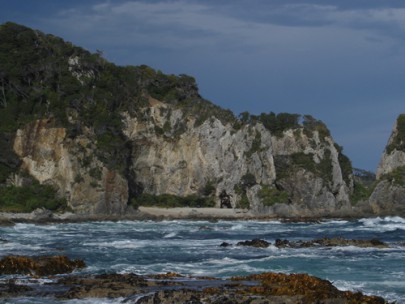Coastal cliffs on acidic rocks
In this section
-
Coastal
- Active sand dunes
- Basic coastal cliffs
- Calcareous coastal cliffs
- Coastal cliffs on acidic rocks
- Coastal cliffs on quartzose rocks
- Coastal rock stacks
- Coastal turfs
- Dune deflation hollows
- Shell barrier beaches ('Chenier plains')
- Shingle beaches
- Stable sand dunes
- Stony beach ridges
- Ultrabasic sea cliffs

Coastal cliffs of acidic rock at Prices Harbour, near Big River in southern Fiordland (Rowan Buxton)
Coastal cliffs are very steep rock faces near the sea that are greater than 5 m in height. They may ascend in steps and have ledges, crevices and overhangs. Coastal cliffs may rise directly from the sea or be separated from it by a narrow shore. Acidic rocks are primarily granite and gneiss, hard sandstones (including greywacke, mudstones), and rhyolite. Cliffs and outcrops provide many varied habitats: from bare rock colonised only by mosses and lichens to deeper soils supporting woody vegetation; from highly exposed situations to heavily shaded and sheltered habitats; and from very dry to permanently wet surfaces. Coastal cliffs are influenced by salt spray, particularly near their bases, and halophytes (salt-tolerant plants) often characterise these habitats. Some widespread native species include New Zealand ice plant (Disphyma australe), small-leaved pohuehue (Muehlenbeckia complexa), silver tussock (Poa cita), New Zealand spinach (Tetragonia implexicoma) and taupata (Coprosma repens). More stable cliffs support pohutukawa (Metrosideros excelsa) treelands such as in Northland, Coromandel and parts of the Bay of Plenty. Floristic richness increases in seepages. Native species that have been lost from neighbouring habitats may find refuge on coastal cliffs.
Synonyms
Coastal cliffs of silicic rocks
Notable flora and fauna
Threatened plants include the nationally critical thick-leaved tree daisy (Olearia pachyphylla), the nationally endangered, forget-me-not (Myosotis petiolata var. pansa), pygmy button daisy (Leptinella nana),and native sowthistle (Picris burbidgeae), the nationally vulnerable Cook’s scurvy grass (Lepidium oleraceum), napuka (Hebe speciosa), purple plume grass (Dichelachne micrantha), and Pimelea tomentosa, the declining coastal mahoe (Melicytus crassifolius), the relict shore puha (Sonchus kirkii) and the naturally uncommon Lyall’s carrot (Anisotome lyallii), Lindsay’s daisy (Celmisia lindsayi), Beddie’s tussock (Chionochloa beddiei), Craspedia (k) (CHR 283173; coast), Helichrysum selago var. tumidum, Pachycladon crenatus, Stewart Island aniseed (Gingidia flabellata), Stewart Island forget-me-not (Myosotis rakiura), Pimelea aff. aridula, Cook Strait bristle grass (Rytidosperma petrosum), and Cook Strait kowhai (Sophora molloyi).
Spotted shags (Stictocarbo punctatus) nest on cliff ledges in Marlborough. Formally these sites would once have had large colonies of sea birds such as petrels.
Threat status
Not threatened (Holdaway et al. 2012)
Threats
Erosion is one of the main threats (although it is a natural process) however, coastal cliffs on hard rocks like granite or gneiss are less frequently undermined by the sea than cliffs composed of softer and more incoherent sandstone or mudstone. Landslides resulting from marine erosion are even more frequent where the rocks are unconsolidated, such as shattered greywacke. The greater openness of cliffs increases susceptibility to weed invasion. There may be some grazing at the tops of sea cliffs. Near urban centres, coastal cliff tops also are desirable locations for dwellings, and rubbish dumping often results.
Where do they occur?
On the North Island, acidic coastal cliffs occur on rhyolite of the Auckland to Coromandel coast and islands, and on interbedded sandstone and mudstone on the east coast of Northland and parts of the Taranaki and Bay of Plenty coastlines. Cretaceous sandstones and conglomerates occur in the northern South island at the Cape Farewell coast, and on greywacke on the southern coast of the North Island at Cape Turakirae. They are more widespread on the South Island, occurring on gneiss along the NW Nelson coast, non-calcareous breccias, sandstones and mudstones of Otago and Southland (including the Catlins coast), and Fiordland, and granites, and other intrusives of Southland and Fiordland. They also occur on Little Barrier Island (rhyolite), and Stephens Island (greywacke) and Stewart Island (granite).
Further reading
Kennedy DM, Dickson ME 2007. Cliffed coasts of New Zealand: perspectives and future directions. Journal of the Royal Society of New Zealand 37: 41-57.
Martin W 1969. New Zealand Lichens and their Habitats. Tuatara 17:20-26.
Wardle P, Mark AF, Baylis GT 1973. Vegetation and Landscape of the West Cape District, Fiordland, New Zealand. New Zealand Journal of Botany 11: 599-626.
Wardle P. 1991. Vegetation of New Zealand. Cambridge University Press. Pp. 375-396.
Wilson JB, Cullen C 1986. Coastal cliff vegetation of the Catlins region Otago, South Island, New Zealand. New Zealand Journal of Botany 24: 567-574.


